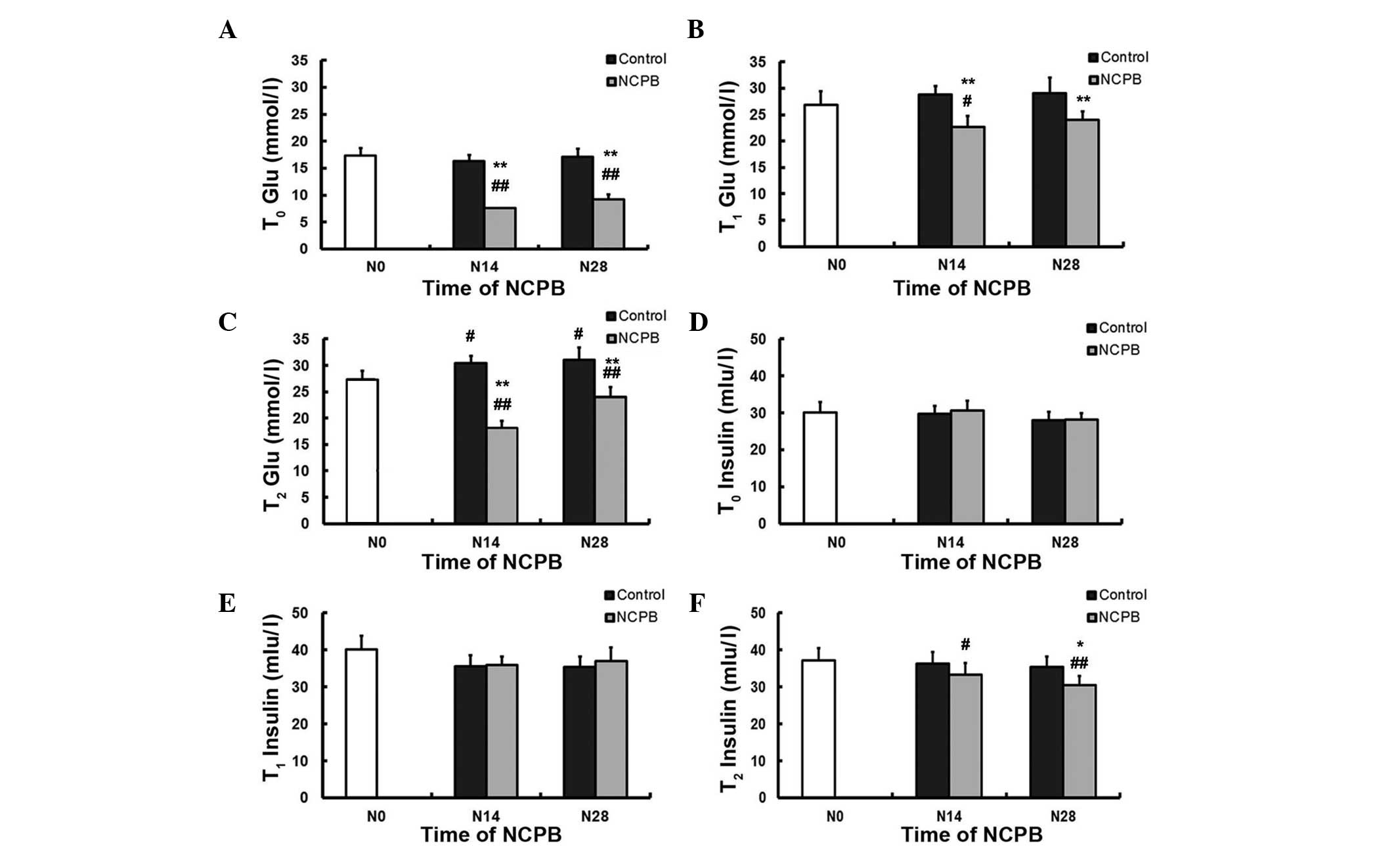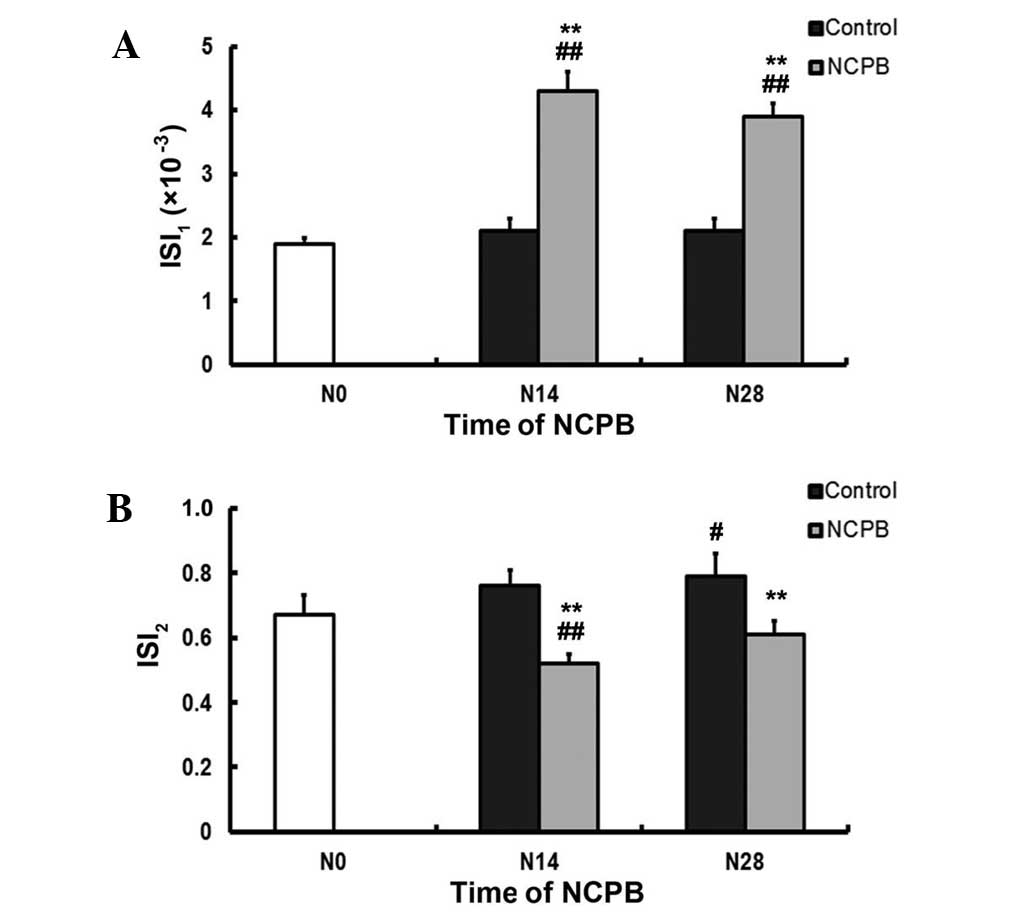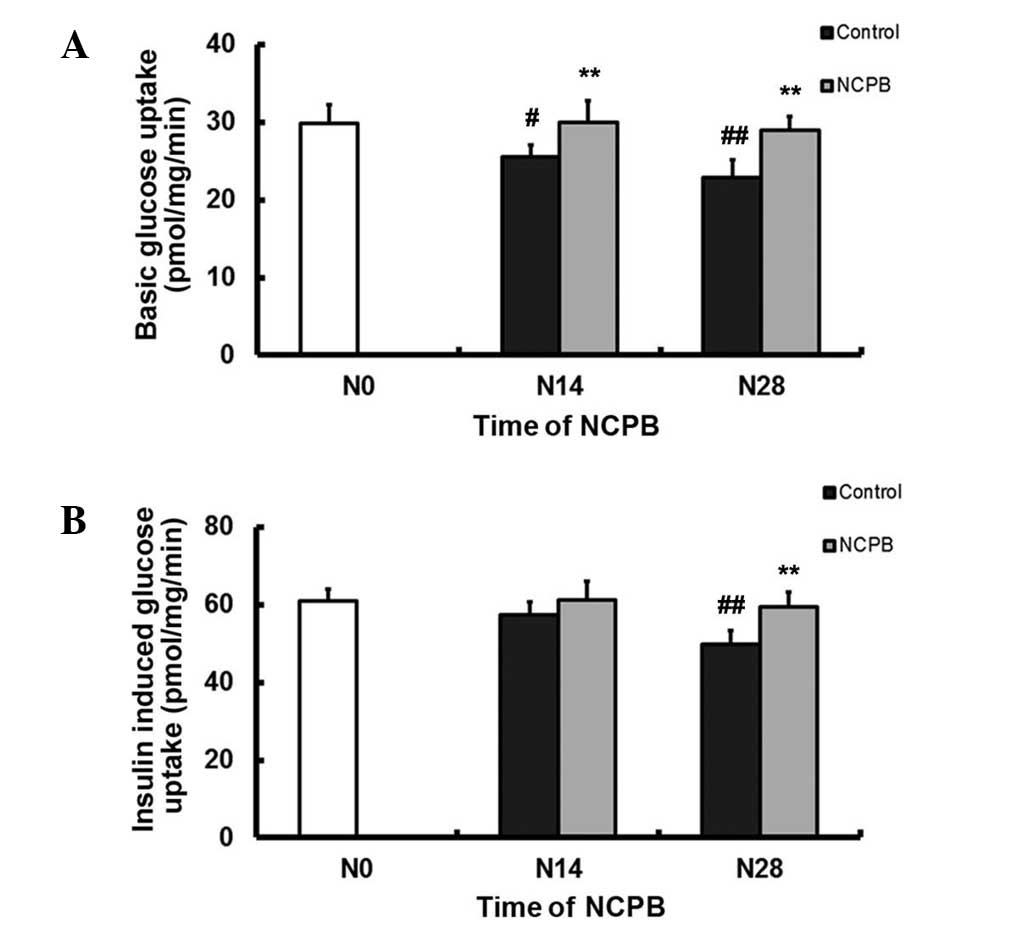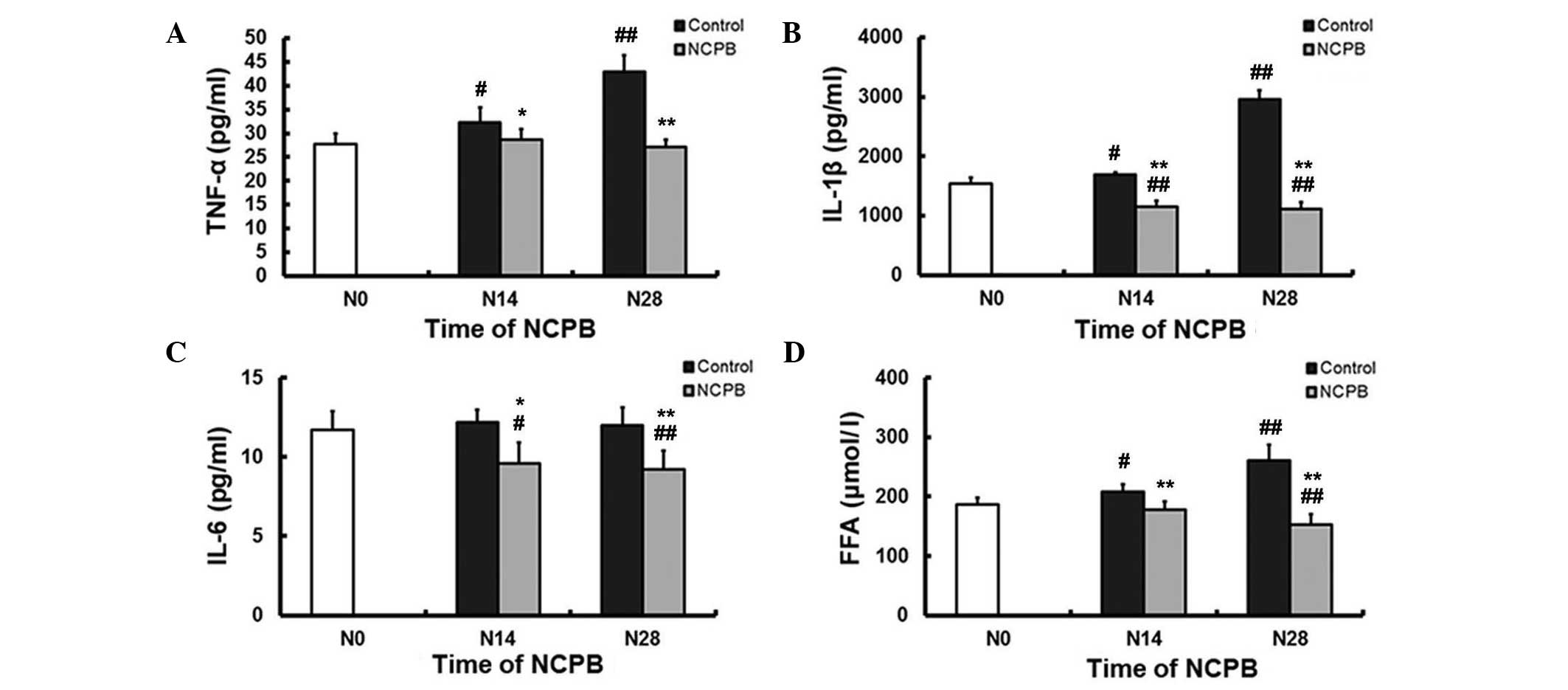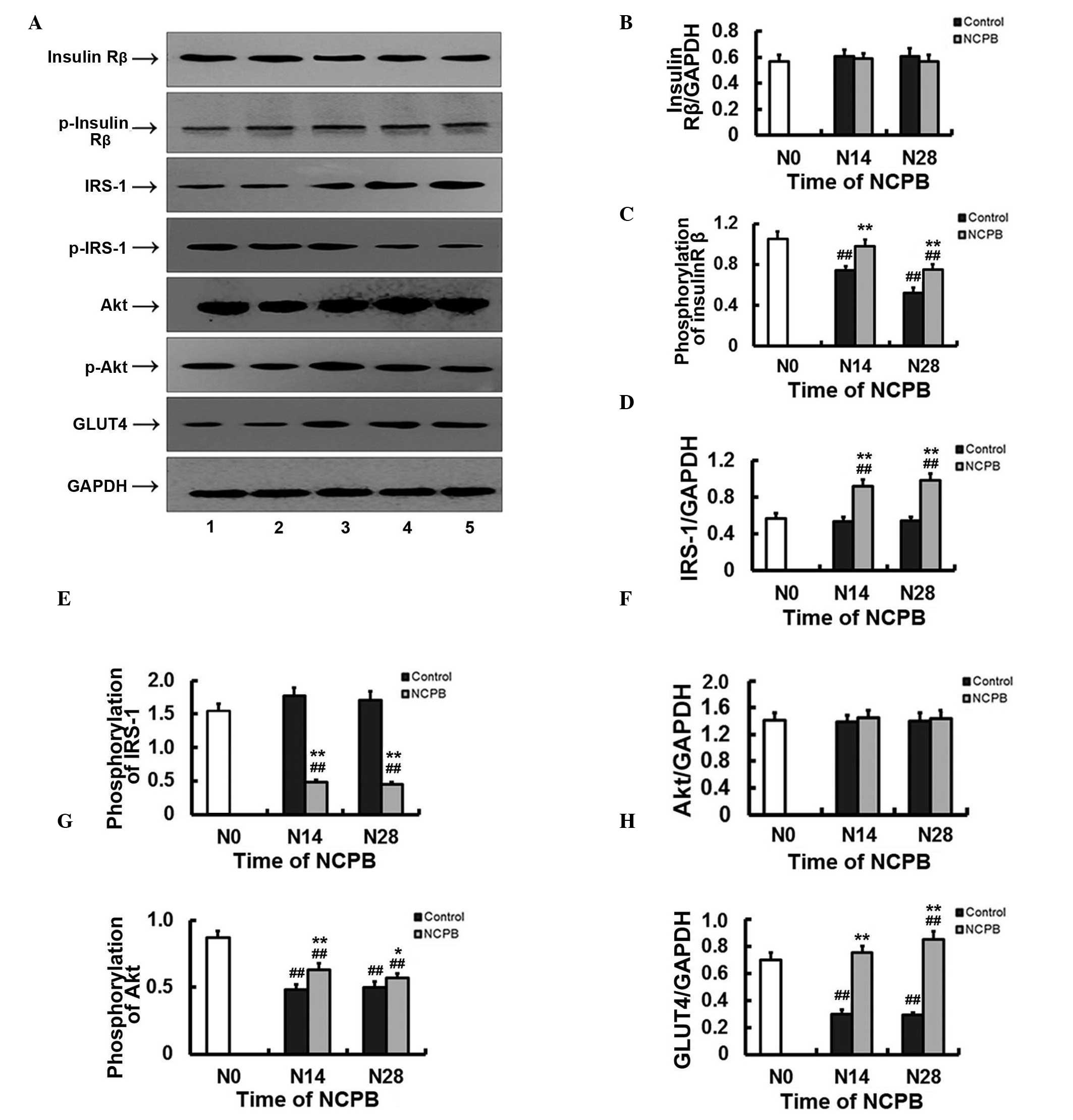|
1
|
Chen L, Magliano DJ and Zimmet PZ: The
worldwide epidemiology of type 2 diabetes mellitus - present and
future perspectives. Nat Rev Endocrinol. 8:228–236. 2011.
View Article : Google Scholar : PubMed/NCBI
|
|
2
|
Brunetti A, Chiefari E and Foti D: Recent
advances in the molecular genetics of type 2 diabetes mellitus.
World J Diabetes. 5:128–140. 2014.PubMed/NCBI
|
|
3
|
Montane J, Cadavez L and Novials A: Stress
and the inflammatory process: A major cause of pancreatic cell
death in type 2 diabetes. Diabetes Metab Syndr Obes. 7:25–34.
2014.PubMed/NCBI
|
|
4
|
Mandrup-Poulsen T: Type 2 diabetes
mellitus: A metabolic autoinflammatory disease. Dermatol Clin.
31:495–506. 2013. View Article : Google Scholar : PubMed/NCBI
|
|
5
|
Eguchi K and Manabe I: Macrophages and
islet inflammation in type 2 diabetes. Diabetes Obes Metab.
15(Suppl 3): 152–158. 2013. View Article : Google Scholar : PubMed/NCBI
|
|
6
|
Richardson VR, Smith KA and Carter AM:
Adipose tissue inflammation: Feeding the development of type 2
diabetes mellitus. Immunobiology. 218:1497–1504. 2013. View Article : Google Scholar : PubMed/NCBI
|
|
7
|
Mackenzie RW and Elliott BT: Akt/PKB
activation and insulin signaling: A novel insulin signaling pathway
in the treatment of type 2 diabetes. Diabetes Metab Syndr Obes.
7:55–64. 2014. View Article : Google Scholar : PubMed/NCBI
|
|
8
|
McPhee JB and Schertzer JD:
Immunometabolism of obesity and diabetes: Microbiota link
compartmentalized immunity in the gut tometabolic tissue
inflammation. Clin Sci (Lond). 129:1083–1096. 2015. View Article : Google Scholar : PubMed/NCBI
|
|
9
|
Tanti JF, Ceppo F, Jager J and Berthou F:
Implication of inflammatory signaling pathways in obesity-induced
insulin resistance. Front Endocrinol (Lausanne). 8:1812013.
|
|
10
|
Jaiswal N, Gunaganti N, Maurya CK,
Narender T and Tamrakar AK: Free fatty acid induced impairment of
insulin signaling is prevented by the diastereomeric mixture of
calophyllic acid and isocalophyllic acid in skeletal muscle cells.
Eur J Pharmacol. 746:70–77. 2015. View Article : Google Scholar : PubMed/NCBI
|
|
11
|
Luo C, Yang H, Tang C, Yao G, Kong L, He H
and Zhou Y: Kaempferol alleviates insulin resistance via hepatic
IKK/NF-κB signal in type 2 diabetic rats. Int Immunopharmacol.
28:744–750. 2015. View Article : Google Scholar : PubMed/NCBI
|
|
12
|
McCall KD, Holliday D, Dickerson E,
Wallace B, Schwartz AL, Schwartz C, Lewis CJ, Kohn LD and Schwartz
FL: Phenylmethimazole blocks palmitate-mediated induction of
inflammatory cytokine pathways in 3T3L1 adipocytes and RAW 264.7
macrophages. J Endocrinol. 207:343–353. 2010. View Article : Google Scholar : PubMed/NCBI
|
|
13
|
Yang FR, Wu BS, Lai GH, Wang Q, Yang LQ,
He MW and Ni JX: Assessment of consecutive neurolytic celiac plexus
block (NCPB) technique outcomes in the management of refractory
visceral cancer pain. Pain Med. 13:518–521. 2012. View Article : Google Scholar : PubMed/NCBI
|
|
14
|
Li J, Wei XH, Lin L, Che JX, Qiu QM, Zuo
HT, An H, Liu YH, Bai SR and Tian FZ: Effect of neurolytic celiac
plexus block on insulin resistance after partial hepatectomy in
rats. Zhongguo Ji Jiu Yi Xue. 33:1124–1126. 2013.(In Chinese).
|
|
15
|
Akash MS, Rehman K and Chen S:
Goto-Kakizaki rats: Its suitability as non-obese diabetic animal
model for spontaneous type 2 diabetes mellitus. Curr Diabetes Rev.
9:387–396. 2013. View Article : Google Scholar : PubMed/NCBI
|
|
16
|
Portha B, Giroix MH, Tourrel-Cuzin C,
Le-Stunff H and Movassat J: The GK rat: A prototype for the study
of non-overweight type 2 diabetes. Methods Mol Biol. 933:125–159.
2012.PubMed/NCBI
|
|
17
|
Chen R, Wang L, Cao HW, Tang CW, Bai XZ
and Ji QH: Expression of GLP-1 receptor mRNA in intestine and
pancreas of diabetic rats. Di 4 Jun Yi Da Xue Xue Bao.
29:1235–1238. 2008.(In Chinese).
|
|
18
|
Li J, Yan HT, Che JX, Bai SR, Qiu QM, Ren
L, Pan F, Sun XQ, Tian FZ, Li DX and Tang LJ: Effects of neurolytic
celiac plexus block on liver regeneration in rats with partial
hepatectomy. PLoS One. 8:e731012013. View Article : Google Scholar : PubMed/NCBI
|
|
19
|
Wincey C and Marks V: A micro-method for
measuring glucose using the autoanalyzer and glucose-oxidase. J
Clin Pathol. 14:558–559. 1961. View Article : Google Scholar : PubMed/NCBI
|
|
20
|
Banerji MA, Chaiken RL, Gordon D, Kral JG
and Lebovitz HE: Does intra-abdominal adipose tissue in black men
determine whether NIDDM is insulin-resistant or insulin-sensitive?
Diabetes. 44:141–146. 1995. View Article : Google Scholar : PubMed/NCBI
|
|
21
|
Ellis L, Clauser E, Morgan DO, Edery M,
Roth RA and Rutter WJ: Replacement of insulin receptor tyrosine
residues 1162 and 1163 compromises insulin-stimulated kinase
activity and uptake of 2-deoxyglucose. Cell. 45:721–732. 1986.
View Article : Google Scholar : PubMed/NCBI
|
|
22
|
Cherqui G, Reynet C, Caron M, Melin B,
Wicek D, Clauser E, Capeau J and Picard J: Insulin receptor
tyrosine residues 1162 and 1163 control insulin stimulation of
myristoyl-diacylglycerol generation and subsequent activation of
glucose transport. J Biol Chem. 265:21254–21261. 1990.PubMed/NCBI
|
|
23
|
Virkamäki A, Ueki K and Kahn CR:
Protein-protein interaction in insulin signaling and the molecular
mechanisms of insulin resistance. J Clin Invest. 103:931–943. 1999.
View Article : Google Scholar : PubMed/NCBI
|
|
24
|
Aguirre V, Werner ED, Giraud J, Lee YH,
Shoelson SE and White MF: Phosphorylation of Ser307 in insulin
receptor substrate-1 blocks interactions with the insulin receptor
and inhibits insulin action. J Biol Chem. 277:1531–1537. 2002.
View Article : Google Scholar : PubMed/NCBI
|
|
25
|
Hsueh WA and Buchanan TA: Obesity and
hypertension. Endocrinol Metab Clin North Am. 23:405–427.
1994.PubMed/NCBI
|
|
26
|
Elmendorf JS, Damrau-Abney A, Smith TR,
David TS and Turinsky J: Phosphatidylinositol 3-kinase and dynamics
of insulin resistance in denervated slow and fast muscles in vivo.
Am J Physiol. 272:E661–E670. 1997.PubMed/NCBI
|
|
27
|
Lee J and Pilch PF: The insulin receptor:
Structure, function and signaling. Am J Physiol. 266:C319–C334.
1994.PubMed/NCBI
|
|
28
|
Kobayashi M, Iwanishi M, Egawa K and
Shigeta Y: Pioglitazone increases insulin sensitivity by activating
insulin receptor kinase. Diabetes. 41:476–483. 1992. View Article : Google Scholar : PubMed/NCBI
|
|
29
|
Ola MS: Effect of hyperglycemia on insulin
receptor signaling in the cultured retinal Müller glial cells.
Biochem Biophys Res Commun. 444:264–269. 2014. View Article : Google Scholar : PubMed/NCBI
|
|
30
|
Fasshauer M, Klein J, Kriauciunas KM, Ueki
K, Benito M and Kahn CR: Essential role of insulin receptor
substrate 1 in differentiation of brown adipocytes. Mol Cell Biol.
21:319–329. 2001. View Article : Google Scholar : PubMed/NCBI
|
|
31
|
Lehr S, Kotzka J, Herkner A, Sikmann A,
Meyer HE, Krone W and Müller-Wieland D: Identification of major
tyrosine phosphorylation sites in the human insulin receptor
substrate Gab-1 by insulin receptor kinase in vitro. Biochemistry.
39:10898–10907. 2000. View Article : Google Scholar : PubMed/NCBI
|
|
32
|
Hotamisligil GS, Peraldi P, Budavari A,
Ellis R, White MF and Spiegelman BM: IRS-1-mediated inhibition of
insulin receptor tyrosine kinase activity in TNF-alpha- and
obesity-induced insulin resistance. Science. 271:665–668. 1996.
View Article : Google Scholar : PubMed/NCBI
|
|
33
|
Aguirre V, Uchida T, Yenush L, Davis R and
White MF: The c-Jun NH(2)-terminal kinase promotes insulin
resistance during association with insulin receptor substrate-1 and
phosphorylation of Ser (307). J Biol Chem. 275:9047–9054. 2000.
View Article : Google Scholar : PubMed/NCBI
|
|
34
|
Anderson KE, Coadwell J, Stephens LR and
Hawkins PT: Translocation of PDK-1 to the plasma membrane is
important in allowing PDK-1 to activate protein kinase B. Curr
Biol. 8:684–691. 1998. View Article : Google Scholar : PubMed/NCBI
|
|
35
|
Cao S, Li B, Yi X, Chang B, Zhu B, Lian Z,
Zhang Z, Zhao G, Liu H and Zhang H: Effects of exercise on AMPK
signaling and downstream components to PI3K in rat with type 2
diabetes. PLoS One. 7:e517092012. View Article : Google Scholar : PubMed/NCBI
|
|
36
|
He L, Simmen FA, Mehendale HM, Ronis MJ
and Badger TM: Chronic ethanol intake impairs insulin signaling in
rats by disrupting Akt association with the cell membrane. Role of
TRB3 in inhibition of Akt/protein kinase B activation. J Biol Chem.
281:11126–11134. 2006. View Article : Google Scholar : PubMed/NCBI
|
|
37
|
Rea S and James DE: Moving GLUT4: The
biogenesis and trafficking of GLUT4 storage vesicles. Diabetes.
46:1667–1677. 1997. View Article : Google Scholar : PubMed/NCBI
|
|
38
|
Mueckler M: Facilitative glucose
transporters. Eur J Biochem. 219:713–725. 1994. View Article : Google Scholar : PubMed/NCBI
|
|
39
|
Mueckler M, Caruso C, Baldwin SA, Panico
M, Blench I, Morris HR, Allard WJ, Lienhard GE and Lodish HF:
Sequence and structure of a human glucose transporter. Science.
229:941–945. 1985. View Article : Google Scholar : PubMed/NCBI
|
|
40
|
Kahn BB: Facilitative glucose
transporters: Regulatory mechanisms and dysregulation in diabetes.
J Clin Invest. 89:1367–1374. 1992. View Article : Google Scholar : PubMed/NCBI
|
|
41
|
Garvey WT, Maianu L, Huecksteadt TP,
Birnbaum MJ, Molina JM and Ciaraldi TP: Pretranslational
suppression of a glucose transporter protein causes insulin
resistance in adipocytes from patients with non-insulin-dependent
diabetes mellitus and obesity. J Clin Invest. 87:1072–1081. 1991.
View Article : Google Scholar : PubMed/NCBI
|
|
42
|
Kelley DE, Mintun MA, Watkins SC, Simoneau
JA, Jadali F, Fredrickson A, Beattie J and Thériault R: The effect
of non-insulin-dependent diabetes mellitus and obesity on glucose
transport and phosphorylation in skeletal muscle. J Clin Invest.
97:2705–2713. 1996. View Article : Google Scholar : PubMed/NCBI
|
|
43
|
Calle MC and Fernandez ML: Inflammation
and type 2 diabetes. Diabetes Metab. 38:183–191. 2012. View Article : Google Scholar : PubMed/NCBI
|
|
44
|
Donath MY: Inflammation as a sensor of
metabolic stress in obesity and type 2 diabetes. Endocrinology.
152:4005–4006. 2011. View Article : Google Scholar : PubMed/NCBI
|
|
45
|
Borst SE: The role of TNF-alpha in insulin
resistance. Endocrine. 23:177–182. 2004. View Article : Google Scholar : PubMed/NCBI
|
|
46
|
Qi C and Pekala PH: Tumor necrosis
factor-alpha-induced insulin resistance in adipocytes. Proc Soc Exp
Biol Med. 223:128–135. 2000. View Article : Google Scholar : PubMed/NCBI
|
|
47
|
Kanety H, Feinstein R, Papa MZ, Hemi R and
Karasik A: Tumor necrosis factor alpha-induced phosphorylation of
insulin receptor substrate-1 (IRS-1). Possible mechanism for
suppression of insulin-stimulated tyrosine phosphorylation of
IRS-1. J Biol Chem. 270:23780–23784. 1995. View Article : Google Scholar : PubMed/NCBI
|
|
48
|
Paz K, Hemi R, LeRoith D, Karasik A,
Elhanany E, Kanety H and Zick Y: A molecular basis for insulin
resistance. Elevated serine/threonine phosphorylation of IRS-1 and
IRS-2 inhibits their binding to the juxtamembrane region of the
insulin receptor and impairs their ability to undergo
insulin-induced tyrosine phosphorylation. J Biol Chem.
272:29911–29918. 1997. View Article : Google Scholar : PubMed/NCBI
|
|
49
|
Heydrick SJ, Jullien D, Gautier N, Tanti
JF, Giorgetti S, Van Obberghen E and Le Marchand-Brustel Y: Defect
in skeletal muscle phosphatidylinositol-3-kinase in obese
insulin-resistant mice. J Clin Invest. 91:1358–1366. 1993.
View Article : Google Scholar : PubMed/NCBI
|
|
50
|
Stephens JM, Lee J and Pilch PF: Tumor
necrosis factor-alpha-induced insulin resistance in 3T3-L1
adipocytes is accompanied by a loss of insulin receptor substrate-1
and GLUT4 expression without a loss of insulin receptor-mediated
signal transduction. J Biol Chem. 272:971–976. 1997. View Article : Google Scholar : PubMed/NCBI
|
|
51
|
Wang CN, O'Brien L and Brindley DN:
Effects of cell-permeable ceramides and tumor necrosis factor-alpha
on insulin signaling and glucose uptake in 3T3-L1 adipocytes.
Diabetes. 47:24–31. 1998. View Article : Google Scholar : PubMed/NCBI
|
|
52
|
Hauner H, Petruschke T, Russ M, Röhrig K
and Eckel J: Effects of tumour necrosis factor alpha (TNF alpha) on
glucose transport and lipid metabolism of newly-differentiated
human fat cells in cell culture. Diabetologia. 38:764–771. 1995.
View Article : Google Scholar : PubMed/NCBI
|
|
53
|
Miles PD, Romeo OM, Higo K, Cohen A,
Rafaat K and Olefsky JM: TNF-alpha-induced insulin resistance in
vivo and its prevention by troglitazone. Diabetes. 46:1678–1683.
1997. View Article : Google Scholar : PubMed/NCBI
|
|
54
|
Lang CH, Dobrescu C and Bagby GJ: Tumor
necrosis factor impairs insulin action on peripheral glucose
disposal and hepatic glucose output. Endocrinology. 130:43–52.
1992. View Article : Google Scholar : PubMed/NCBI
|
|
55
|
Yu C, Chen Y, Cline GW, Zhang D, Zong H,
Wang Y, Bergeron R, Kim JK, Cushman SW, Cooney GJ, et al: Mechanism
by which fatty acids inhibit insulin activation of insulin receptor
substrate-1 (IRS-1)-associated phosphatidylinositol 3-kinase
activity in muscle. J Biol Chem. 277:50230–50236. 2002. View Article : Google Scholar : PubMed/NCBI
|
|
56
|
Hotamisligil GS and Spiegelman BM: Tumor
necrosis factor alpha: A key component of the obesity-diabetes
link. Diabetes. 43:1271–1278. 1994. View Article : Google Scholar : PubMed/NCBI
|
|
57
|
Takaesu G, Ninomiya-Tsuji J, Kishida S, Li
X, Stark GR and Matsumoto K: Interleukin-1 (IL-1)
receptor-associated kinase leads to activation of TAK1 by inducing
TAB2 translocation in the IL-1 signaling pathway. Mol Cell Biol.
21:2475–2484. 2001. View Article : Google Scholar : PubMed/NCBI
|
|
58
|
Emanuelli B, Glondu M, Filloux C, Peraldi
P and Van Obberghen E: The potential role of SOCS-3 in the
interleukin-1beta-induced desensitization of insulin signaling in
pancreatic beta-cells. Diabetes. 53(Suppl 3): S97–S103. 2004.
View Article : Google Scholar : PubMed/NCBI
|
|
59
|
Rui L, Yuan M, Frantz D, Shoelson S and
White MF: SOCS-1 and SOCS-3 block insulin signaling by
ubiquitin-mediated degradation of IRS1 and IRS2. J Biol Chem.
277:42394–42398. 2002. View Article : Google Scholar : PubMed/NCBI
|
|
60
|
Fujishiro M, Gotoh Y, Katagiri H, Sakoda
H, Ogihara T, Anai M, Onishi Y, Ono H, Funaki M, Inukai K, et al:
MKK6/3 and p38 MAPK pathway activation is not necessary for
insulin-induced glucose uptake but regulates glucose transporter
expression. J Biol Chem. 276:19800–19806. 2001. View Article : Google Scholar : PubMed/NCBI
|
|
61
|
Eguez L, Lee A, Chavez JA, Miinea CP, Kane
S, Lienhard GE and McGraw TE: Full intracellular retention of GLUT4
requires AS160 Rab GTPase activating protein. Cell Metab.
2:263–272. 2005. View Article : Google Scholar : PubMed/NCBI
|
|
62
|
Jager J, Grémeaux T, Cormont M, Le
Marchand-Brustel Y and Tanti JF: Interleukin-1beta-induced insulin
resistance in adipocytes through down-regulation of insulin
receptor substrate-1 expression. Endocrinology. 148:241–251. 2007.
View Article : Google Scholar : PubMed/NCBI
|
|
63
|
Kim JA, Yeh DC, Ver M, Li Y, Carranza A,
Conrads TP, Veenstra TD, Harrington MA and Quon MJ: Phosphorylation
of Ser24 in the pleckstrin homology domain of insulin receptor
substrate-1 by Mouse Pelle-like kinase/interleukin-1
receptor-associated kinase: Cross-talk between inflammatory
signaling and insulin signaling that may contribute to insulin
resistance. J Biol Chem. 280:23173–23183. 2005. View Article : Google Scholar : PubMed/NCBI
|
|
64
|
Lagathu C, Bastard JP, Auclair M, Maachi
M, Capeau J and Caron M: Chronic interleukin-6 (IL-6) treatment
increased IL-6 secretion and induced insulin resistance in
adipocyte: Prevention by rosiglitazone. Biochem Biophys Res Commun.
311:372–379. 2003. View Article : Google Scholar : PubMed/NCBI
|
|
65
|
Senn JJ, Klover PJ, Nowak IA and Mooney
RA: Interleukin-6 induces cellular insulin resistance in
hepatocytes. Diabetes. 51:3391–3399. 2002. View Article : Google Scholar : PubMed/NCBI
|
|
66
|
Sun Y, Liu S, Ferguson S, Wang L, Klepcyk
P, Yun JS and Friedman JE: Phosphoenolpyruvate carboxykinase
overexpression selectively attenuates insulin signaling and hepatic
insulin sensitivity in transgenic mice. J Biol Chem.
277:23301–23307. 2002. View Article : Google Scholar : PubMed/NCBI
|



